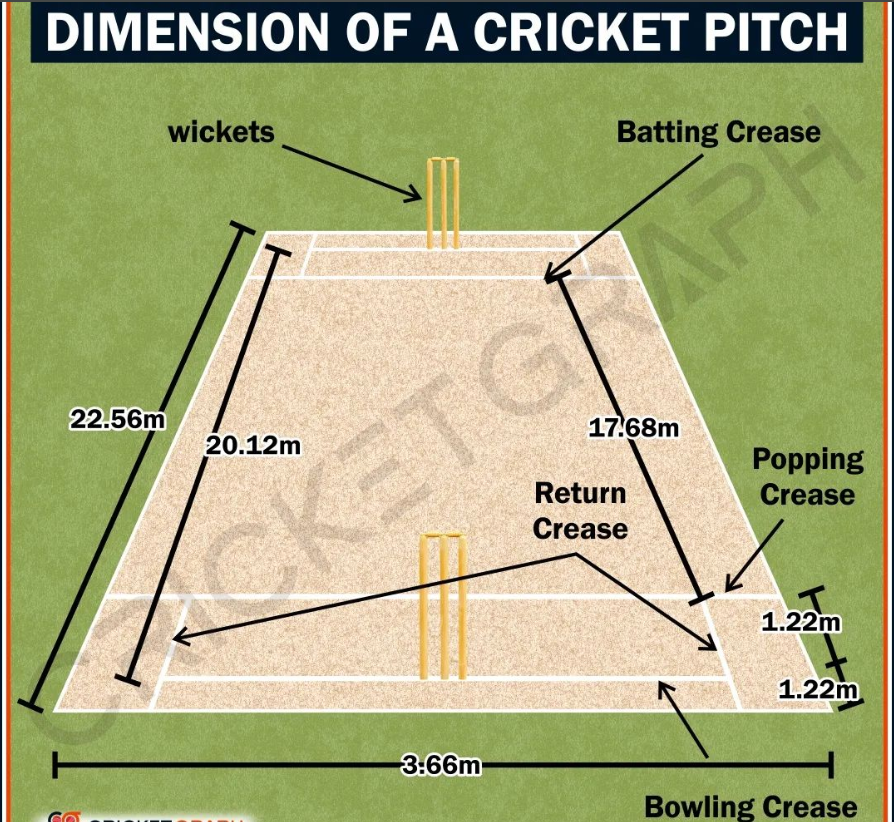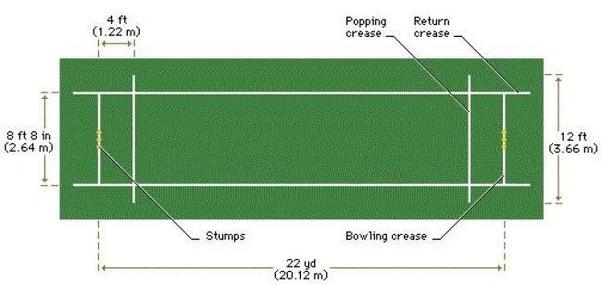
Cricket fields may vary in shape but typically feature a rectangular shape for the outer field and pitch, with a curved boundary for the inner field. While there are no official field size rules, the cricket pitch size is critical to the game. In men’s cricket, the standard pitch length is 22 yards. Similarly, in women’s cricket, pitch length is the same as that of men. The cricket pitch serves as the central stage for the game’s action. Despite its significance, the dimensions of a cricket pitch are often overlooked. Understanding the cricket pitch’s measurements, including its length and shape, is not just a technicality but a key to fully appreciating the game for both players and spectators. So, let’s find the details of the women’s cricket pitch, exploring its various aspects, from dimensions to types.
What is a Women’s Cricket pitch?
The cricket pitch stands as the central focal point of the cricket field, commanding attention throughout the match. Its dimensions, crucial to the game’s dynamics, measure 10 feet (3.05 m) in width and 22 yards (20.12 m) in length. This flat expanse is significant in the game, affecting the ball’s bounce when bowled towards the batsman. The wickets are positioned at each end of the pitch, serving as the targets for both bowlers and batsmen. The bowler delivers the ball from one end of the pitch to the opposite wicket or batsman’s ground. Failure to do so accurately results in penalties such as no-balls or wides. Both players and fans need to understand the women’s cricket pitch. This includes knowing its size and how it affects the game. The pitch plays a big role in cricket, and understanding it adds to the enjoyment of watching or playing the sport.
Women’s Cricket Pitch Measurement and Dimensions
The women’s cricket pitch measures 20.12 meters from one set of stumps to the other, with an extra 1.22 meters behind the stumps for the return crease and bowler’s approach area. The grassy area surrounding the pitch is 3.05 meters wide. The size of the turf wicket may vary depending on the level of the cricket match being played. This rectangular space is where the bowler throws the ball and where the stumps and creases are marked at each end. The pitch is where most of the cricket match’s action unfolds. One thing that has not changed over the years is the cricket pitch’s measurements.
What is the Women’s cricket pitch length?
Understanding the length of the cricket pitch is crucial for setting up the various components on the field, like the crease and wickets. It serves as the foundation for organizing the game properly. Cricket, being a colonial game, traditionally used old-fashioned measurements like yards. However, modern methods, including the metric system, are also used to measure cricket pitches today. This ensures accuracy and consistency across matches. Knowing the exact length of the pitch helps players, groundsmen, and officials maintain the integrity of the game, ensuring a fair and enjoyable playing experience for everyone involved.
Types Of Women’s Cricket Pitch
Measuring the length of a cricket pitch can be done simply by counting steps.
An average adult can cover around 10 meters in about 13 steps.
- The pitch length takes about 26 steps from one set of wickets to the other.
- It is about 23 steps from crease to crease.
- From edge to edge, it is approximately 29 steps.
These official women’s cricket pitch length measurements provide a handy way to understand the size of the pitch without any specialized equipment. It is a practical method anyone can use, whether players, coaches, or ground staff. Understanding these measurements helps ensure the pitch is set up correctly and maintains the standard dimensions for fair play. While traditional measuring methods like yards are still used in cricket, counting steps offers a straightforward and accessible alternative, particularly for informal games or when precise equipment isn’t available. So, whether you’re preparing a pitch for a professional match or just having a friendly game with friends, knowing how to measure it with steps can be handy.
What is the shape of a Women’s cricket pitch?
The “square” is right next to the pitch where the main game happens. Pitches can be made anywhere on the square.
Then there is the outfield, which is the area outside the square. Even though people talk about the square and the outfield a lot, they don’t affect the game’s rules. Something interesting about the square is that the grass there is shorter because it has been used in previous games. Because of that, the ball tends to roll faster when it rolls over the square.
And just like in men’s cricket, women’s cricket also has the same square and outfield setup. So, whether you’re watching men’s or women’s cricket, you’ll hear about the square and the outfield, but they’re less important than the pitch where all the action happens!

Different Women’s Cricket Pitch Areas

In women’s cricket, various areas on the pitch play important roles in determining the course of the game. Let’s break down the cricket pitch dimensions for women into easy-to-understand terms.
1. Creases:
- Bowling Crease: This is where the bowler delivers the ball. It’s marked by a line perpendicular to the pitch’s length and where the stumps are placed.
- Popping Crease: Positioned in front of the bowling crease, this line serves multiple purposes, including marking the batsman’s safe zone and determining front-foot no-balls.
- Return Crease: Two lines parallel to the bowling crease and perpendicular to it. These are located on either side of the wicket and are crucial for determining wides and no-balls.
These creases serve as essential markers on the pitch, ensuring fair play and adherence to rules. They play the same role in women’s cricket matches as men’s.
2. Wickets:
- Stumps: Each wicket consists of three stumps, the vertical posts placed at each end of the pitch. These stumps total six in quantity, standing on both sides of the pitch.
- Bails: Two bails, which are smaller wooden pieces, lie atop the stumps to maintain their balance.
The wickets are the ultimate target for both the bowler and the fielding team, as their removal signifies the dismissal of a batsman.
Understanding these areas is crucial for players, umpires, and spectators alike, as they govern the flow and outcomes of the game. Whether the bowler is aiming for a wicket or the batsman is trying to stay within the crease, these elements shape the dynamics of cricket matches. In women’s cricket, the significance of these areas remains the same, contributing to the excitement and strategy of the game.
Does the Women’s cricket pitch length change?
In cricket, the pitch length usually stays the same, no matter where you play. It is always 22 yards for adults, the distance from one set of stumps to another. But for younger players, like those under 15, the pitch might be shorter. Under 13s play on a 21-yard pitch and 11s on a 19-yard one.
There is a special rule for U11 and U13 games. If putting the stumps in the usual spot would mess up the big pitch (because of footprints from the batsmen), the coaches of both teams can agree to make the pitch longer. This helps protect the main pitch.
The pitch for women’s cricket is 22 yards, the same length as the adult men’s. So, the cricket pitch length is the same for every adult, male or female.
Remember, the pitch length doesn’t change in professional games, but it might be adjusted for younger players to keep things fair and safe for everyone.
Conclusion
Cricket is a popular sport with its special language. It is important to know the difference between the field and the pitch. The field is the big area where players wait for the ball, but the pitch is where the bowler throws the ball to the batter.
In cricket, the bowler and the batter are in a direct contest on the pitch. They are the main players in the game. And there’s something called the leg side, which is like an unofficial part of the field.
The women’s cricket pitch length is the same as the men’s. They both play on a 22-yard pitch, so everyone competes on the same size pitch.
Understanding cricket lingo and knowing the difference between the field and the pitch is essential for enjoying the game fully!


